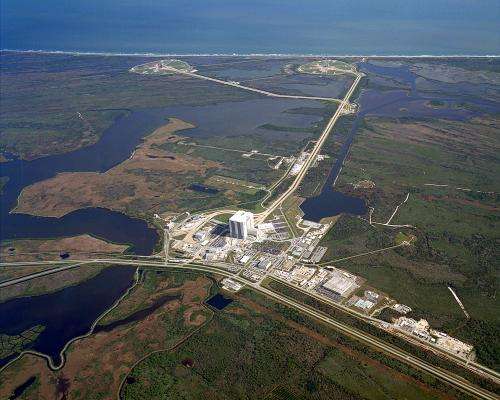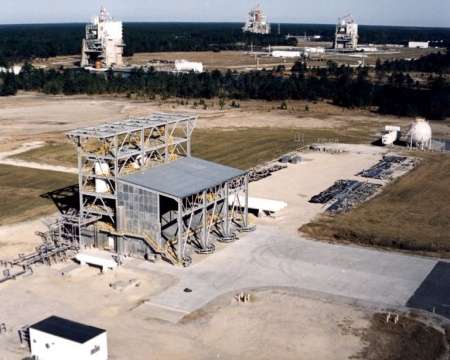NASA sites across US vulnerable to climate change

The National Aeronautics and Space Administration has been at the forefront of climate science, launching satellites that take the pulse of Earth's land, oceans and atmospheric systems, gathering data on climate, weather and natural hazards. But the agency is increasingly vulnerable itself to the effects of a changing climate.
Hurricane Isabel partially flooded the Langley Research Center in Virginia in 2003; Hurricane Frances damaged the Kennedy Space Center in Florida in 2004; and Hurricane Katrina damaged buildings at the Stennis Space Center in Mississippi in 2005, among recent incidents. Other facilities have been damaged or threatened by tornadoes and wildfires.
A new study in the latest issue of the Bulletin of the American Meteorological Society found that NASA facilities and its overall mission could be threatened by an increase in extreme weather events and expected sea level rise. Using weather data and climate models, the study looked at how NASA facilities have been affected by climate change, including extreme weather events, and how the agency is preparing for the future.
With major facilities located along coastlines, NASA is particularly vulnerable to sea level rise. The study found that sea level rise could lead to an increase of 50 percent or more in coastal flooding frequency by the 2050s.
"It's a great experience working at NASA Centers across the country to enhance climate resilience. They are explicitly taking increasing risks due to climate change into account in their operations and planning," said Cynthia Rosenzweig, lead author of the study and a scientist at NASA's Goddard Institute for Space Studies in New York, which is affiliated with The Earth Institute.

Rosenzweig heads the Climate Adaptation Science Investigator working group, which brings together climate scientists, mission operations personnel, human resource managers and ecosystem specialists to study and plan for the management of climate risks. NASA operates some $32 billion in facilities and has about 64,000 employees, contractors and partners.
At the Kennedy Space Center in Florida, home of NASA's premiere launch facility, launch pads and other facilities could experience inundation due to rising sea level and coastal flooding, according to one in a series of reports on NASA facilities prepared by the working group.
The added flooding and an increase in heavy precipitation events could mean increased erosion of coastline and changes in shoreline habitats, and challenges to stormwater and wastewater management systems. Higher average temperatures would add to cooling costs, increased restrictions on outdoor labor and damage to infrastructure materials, the report says. On the plus side, the prediction of fewer days before freezing would mean reduced heating costs and possible expansion of launch windows.
"Actual weather data collected over the past 100 years in Florida point to one undeniable fact: average temperatures and sea level are rising," the report says. "In addition, climate models project accelerated temperature and sea level rise and an increase in extreme weather events—including heat waves, coastal flooding, and intense precipitation—for the Space Coast in the future.
"Already, the area shows signs of climate vulnerability: Outdoor work schedules must accommodate increasing temperatures, storm surges regularly breach the dunes near the launch pads, and sea
turtles were rescued during a January 2010 cold stun event," the report says.
The area also encompasses the Cape Canaveral Air Force Station and large swaths of coastal habitat that is home to many types of wildlife. The federal aerospace facilities – and associated businesses and tourism – add substantially to the state's economy. NASA alone contributes an estimated $4.1 billion, according to one state-sponsored report.
The Space Center's launch facilities provide "a critical asset for the nation—access to orbits that cannot be obtained from launches anywhere else in the U.S.," the NASA report says.
While the Goddard Institute for Space Studies studies the solar system, stars and planets, it also has focused on Earth systems, including atmosphere and climate, and has become a key center for the development of atmospheric modeling and understanding climate change.
More information:
Cynthia Rosenzweig, Radley M. Horton, Daniel A. Bader, Molly E. Brown, Russell DeYoung, Olga Dominguez, Merrilee Fellows, Lawrence Friedl, William Graham, Carlton Hall, Sam Higuchi, Laura Iraci, Gary Jedlovec, Jack Kaye, Max Loewenstein, Thomas Mace, Cristina Milesi, William Patzert, Paul W. Stackhouse Jr., and Kim Toufectis, 2014: "Enhancing Climate Resilience at NASA Centers: A Collaboration between Science and Stewardship." Bull. Amer. Meteor. Soc., 95, 1351–1363.
doi: dx.doi.org/10.1175/BAMS-D-12-00169.1
Journal information: Bulletin of the American Meteorological Society
Provided by Columbia University




















